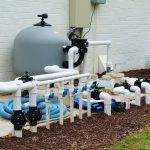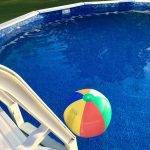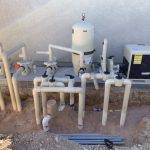What it is – One of the most common mechanical pool issues, a suction side leak can be difficult to find. The effect is just like using a straw with a hole in it. A suction side air leak shows itself most commonly by bubbles and splashing and frothing in the pump basket. This indicates your pump is not getting the water it needs to function smoothly but, instead, air is getting into the system and starving or semi-starving the pump. The pump basket can have absolutely no water whatsoever (that’s when it “loses prime”) or it can have a mixture of water and air frothing around, or it can be a stream of tiny bubbles…..often easy to overlook. In any case, it is still an air leak and should be fixed.
Other indicators that you have this leak are bubbles coming back into the pool from the returns or perhaps having to constantly “bleed” this accumulated air from your filter.
Where it is – Air leaks occur only on the suction side of your system. The suction side is defined as starting at the skimmer and continuing until it gets to the pump impeller.
How to fix it – Simply stop the source where the air is getting in……simple enough, huh?
Finding the source of that leak or those leaks (you can have more than one at the same time) will be 90% of your work. Fixing it will be normally quick and easy.
Here are a few of the common sources for these leaks:
1. The most common source is the pump basket lid. It must have an airtight seal. Replacing the O-ring often helps. Cleaning and lubrication of the O-ring with a silicone based lubricant (Magic Lube is one brand) may be necessary. Do not use WD-40 or petroleum jelly.
Often, you can confirm this as the source by slowly pouring water over the lid with the pump running to see if that stops or minimizes the air in the basket.
2. Most all pumps have two drain plugs. One is near the bottom of the basket and the other further back on the motor side of the pump. Only the basket drain can introduce air into the pump. Remove the plug and inspect the O-ring. Replace if split or deformed, lube the O-ring and reinstall the plug snugly.
3. Poorly made or broken, cracked PVC joints. If it looks sloppily made or crooked, it should be VERY suspect. Sometimes you can identify them by using the same running water technique as the one for the lid above. The fix is to cut out and remake that joint.
4. All valves. They can be cracked or perhaps need new seals. Identify by listening closely or by pouring water over them as in #1.
5. The pool water level. While the pump is running, visually inspect the skimmer(s) to make sure absolutely no air is drawn down into the skimmer(s). To fix, add more water to the pool and make sure that the weir (flapper) door operates correctly.
6. If your pump or plumbing “spits” a little water from somewhere when the pump shuts off, that often indicates the location of an air leak.
If you inspect each of the above, there is a good chance you will find the leak. Don’t waste your time looking around the filter or other equipment. This is all located on the pressure side of your system and cannot produce an air leak. The pressure side can only produce a water leak.
Be very methodical when you attempt to find the leak(s). It can be painstakingly slow and subtle. Once you find it, the fix will be the easy part of the job.
Though underground plumbing leaks are less common than many people fear, if you are unable to locate a leak above ground, it may be worthwhile to dig down to the first fitting below the surface on the pump inlet lines. These are the source of many plumbing leaks and are generally not far below ground.





